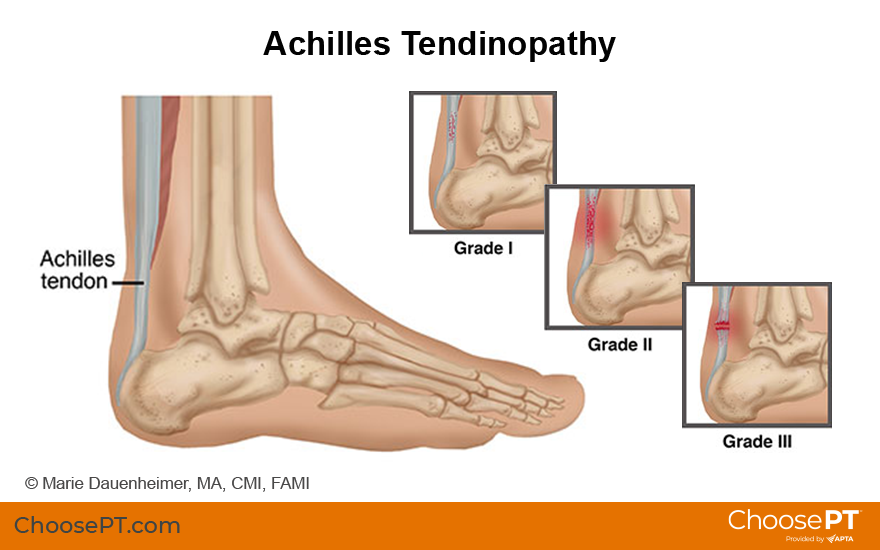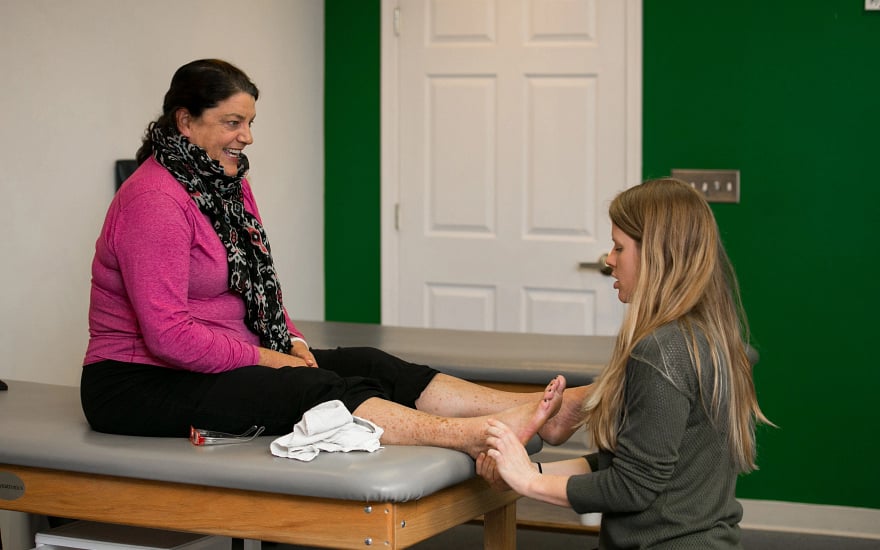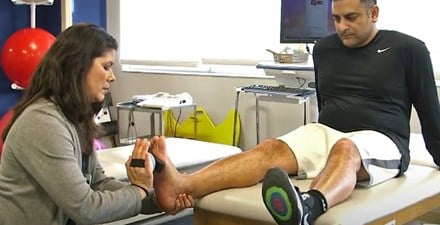Physical Therapy Guide to Achilles Tendinopathy
Achilles tendinopathy is an irritation of the Achilles tendon. It is one of the most common types of pain felt behind the heel and up the back of the ankle when walking or running. It affects both active and inactive people. More than 40% of all elite track-and-field athletes may experience symptoms. But about 65% of cases are not sports-related.
Achilles tendinopathy can limit a person's ability to walk, climb stairs, or participate in activities. Physical therapists help people with the condition reduce pain and restore strength and movement.
Physical therapists are movement experts. They improve quality of life through hands-on care, patient education, and prescribed movement. You can contact a physical therapist directly for an evaluation. To find a physical therapist in your area, visit Find a PT.
What Is Achilles Tendinopathy?
Achilles tendinopathy is an irritation of the Achilles tendon, a thick band of tissue that runs up the back of the lower leg. This tendon connects the calf muscles to the heel. The term "tendinopathy" refers to any problem with a tendon, either short- or long-term. The Achilles tendon transmits force from the calf muscles to the foot when a person pushes off the ground (such as when running or jumping). It also helps control ankle position when the foot touches back down on the ground.
Achilles tendinopathy occurs when the demand on the Achilles tendon exceeds its ability to function. The condition is most common in people ages 35-55 but can affect anyone. It can occur after a single injury (acute) or with repetitive irritation (chronic). Achilles tendon pain often results from repeated trauma without proper recovery or rest. This can lead to chronic conditions, making it harder to walk, run, and jump. It is most often treated with physical therapy.
Achilles tendinopathy is linked to several different factors, including:
- Calf muscle tightness
- Calf muscle weakness
- Gluteal (buttocks) muscle weakness
- Limited ankle motion
- Abnormal foot mechanics
- Improper footwear
- Changes in exercise/activity level
Pain can occur along the Achilles tendon or where the tendon meets the heel. The most common area to feel tenderness is just above the heel.

How Does It Feel?
With Achilles tendinopathy, you may experience:
- Tenderness in the heel or higher up in the Achilles tendon when pressed
- Pain and stiffness with walking, especially during the first few steps
- Pain and stiffness that gets worse with prolonged activity
- Pain with flexing the foot
- Calf tightness
- Swelling at the back of the ankle
How Is It Diagnosed?
Your physical therapist will review your health history and examine your heel, ankle, and calf. They will check your foot posture, strength, flexibility, and movement. This may include watching how you stand, walk, squat, step onto a stair, or hop. They may also assess the motion and strength in other parts of your leg and hips.
Your physical therapist may ask questions to identify any outside factors to your condition. They may ask about your daily activities, exercise routine, and footwear.
Imaging techniques, such as X-rays or MRI, are often not needed to diagnose Achilles tendinopathy. Surgery is often unlikely. However, your physical therapist may consult with an orthopedist or other health care professionals if your injury does not respond to proper care.
How Can a Physical Therapist Help?

Physical therapy can address any factors causing your condition. These include pain, swelling, or lack of strength, flexibility, or body control. You and your physical therapist will work together to develop your personalized treatment program. It will be tailored to help you reach your specific goals in the safest and most effective way possible. Your treatments may include:
Education. Your physical therapist may identify external factors that can contribute to your pain. These may include the type and level of your activities and your footwear.
Pain management. Your physical therapist can use many pain-relief strategies. These can include applying ice to the area or using heel lifts or rigid taping. They also may use therapies, such as iontophoresis (an electrically charged medicated patch) or ultrasound. These strategies can help reduce the need for pain medication, including opioids.
Manual therapy. Your physical therapist may apply hands-on treatments to gently move your muscles and joints. This can help improve their motion and function. These techniques often address areas that are difficult to treat on your own.
Range-of-motion treatments. Improper movement in the ankle, foot, knee, or hip can place excess strain on the Achilles tendon. Your physical therapist may apply massage and guided movements as treatment. They may teach you self-stretching exercises. Stretching can help normalize your movement, decrease tension, and restore your full range of motion.
Gentle exercise. Applying weight or resistance to the tendon through gentle exercise can aid recovery from pain. Your physical therapist will teach you to perform gentle strengthening exercises in a seated position. These can include pushing and pulling a resistance band with your foot. You then may advance to exercises in a standing position, such as standing heel raises. Your physical therapist will decide what exercise is best for you.
Muscle-strengthening exercises. Muscle weakness or imbalance can put strain on the Achilles tendon. Based on your specific condition, your physical therapist will design a lower-extremity resistance program. Following it can help correct any weakness-associated movement errors that may be causing pain.
Functional training. Once your pain eases and your strength and motion improve, you can safely transition to more demanding activities. Your physical therapist will design a program of safe and controlled movements to ease tension on your Achilles tendon. This will help reduce your risk of reinjury. Your physical therapist will create a series of specific activities to help you learn to use and move your body correctly. You’ll be better able to safely do the tasks required to achieve your goals.
If additional therapies are needed, such as surgery, your physical therapist will work with you after your procedure to help you regain motion, strength, and function.
Can This Injury or Condition Be Prevented?
Maintaining lower-extremity mobility and strength is a key to prevention. Engage in safe, regular exercise. Pay close attention to your exercise routine. Note any changes in an exercise surface, the volume of exercises performed, and your footwear. This will help reduce the risk of injury.
When you have experienced an injury, seek physical therapy. Your physical therapist will help ease any pain or stress on the tendon. They will help guide you to slowly add activities back into your routine without worsening your symptoms. Keep in mind that returning to high-level activities too soon after injury can lead to another episode of pain.
What Kind of Physical Therapist Do I Need?
All physical therapists are educated to treat Achilles tendinopathy. However, you may want to consider seeing a physical therapist who is:
- Experienced in treating people with Achilles tendinopathy. Some physical therapists have a practice with an orthopedic or musculoskeletal focus.
- A board-certified orthopedic clinical specialist who has completed a residency or fellowship in orthopedic or sports physical therapy. This physical therapist has advanced knowledge, experience, and skills that may apply to your condition.
To find a physical therapist with specific expertise near you, use Find a PT, the American Physical Therapy Association's online tool to search for physical therapists with specific clinical expertise in your geographic area.
Tips for Choosing and Seeing a Physical Therapist (or Any Health Care Provider):
- Seek recommendations from family, friends, or other health care providers.
- Ask about the physical therapists' experience in treating people with Achilles tendinopathy when scheduling an appointment.
- Be prepared to describe your symptoms in detail, and say what makes them worse.
The American Physical Therapy Association advocates for consumer access to information that:
- Supports informed health care decisions
- Helps patients prepare for visits with their health care provider
These articles present some of the best scientific evidence on Achilles tendinopathy treatment. They include recent research and give an overview of the standards of practice in the United States and internationally. Each title links to either a PubMed* abstract of the article or a free full-text article, which you can read or share with your health care provider.
Baxter JR, Corrigan P, Hullfish TJ, et al. Exercise progression to incrementally load the Achilles tendon. Med Sci Sports Exerc. 2021;53(1):124–130. Article Summary in PubMed.
Silbernagel KG, Hanlon S, Sprague A. Current clinical concepts: conservative management of Achilles tendinopathy. J Athl Train. 2020;55(5):438–447. Article Summary in PubMed.
Martin RL, Chimenti R, Cuddeford T, et al. Achilles pain, stiffness, and muscle power deficits: midportion Achilles tendinopathy revision 2018. J Orthop Sports Phys Ther. 2018;48:A1–A38. Article Summary in PubMed.
Habets B, van den Broek AG, Huisstede BMA, et al. Return to sport in athletes with midportion Achilles tendinopathy: a qualitative systematic review regarding definitions and criteria. Sports Med. 2018;48(3):705–723. Article Summary in PubMed.
Jonsson P, Alfredson H, Sunding K, et al. New regimen for eccentric calf-muscle training in patients with chronic insertional Achilles tendinopathy: results of a pilot study. Br J Sports Med. 2008;42:746–749. Article Summary on PubMed.
Maffulli N, Wong J, Almekinders LC. Types and epidemiology of tendinopathy. Clin Sports Med. 2003;22:675–692. Article Summary on PubMed.
*PubMed is a free online resource developed by the National Center for Biotechnology Information. PubMed contains millions of citations to biomedical literature, including citations in the National Library of Medicine's MEDLINE database.
Expert Review:
May 7, 2025
Revised:
Sep 2, 2025
Content Type: Guide
Achilles Tendinopathy
PT, DPT, Board-Certified Clinical Specialist in Sports Physical Therapy
Kiera Olson
PT, DPT
Dave Nolan
PT, DPT, MS, Board-Certified Specialist in Orthopedic and Sports Physical Therapy, Certified Strength and Conditioning Specialist
You Might Also Like...
Video
Physical Therapy Helps Runner Get Back on the TrailNov 6, 2019
After Achilles tendon reconstruction, Anush was in a boot for over 6 months. He started physical therapy while in his boot, including manual therapy and
Health Tips
Top 4 Running Injuries Physical Therapists Help ManageFeb 11, 2019
There are numerous benefits to running, including improved cardiovascular, mental, and physical health, to name a few. Avid runners would love to live

